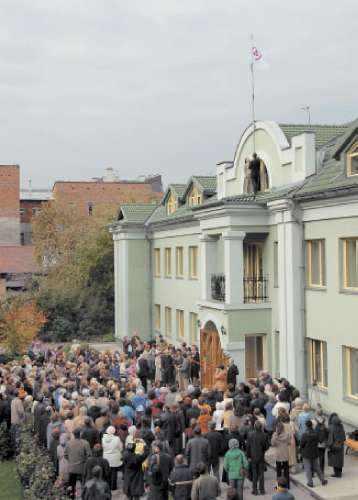

Dedicate yourselves to the task of gathering the people and, with them, erecting My Temple.
Leaves of Morya’s Garden, 160
Amazing is the scope of Roerich’s mighty realm. Great number of the paintings, articles, institutions, endeavors... As Academician Okladnikov said, ‘What is done by Roerich, changes one’s conception of human abilities.’ He who came to fulfill the dictate of the Cosmic terms, who gave new evolutionary impulse to human aspirations, he not only brought the Tidings, but also embodied into beautiful material forms the entrusted to him pearls of Beauty of the Higher World.
Nicholas Roerich was a pioneer in whatever he did. First in the history of culture he gave completely new explanation to such notions as Culture, Art, Museum, Creation... He considered as cultural legacy only the things which reveal the ethical foundations of life. ‘Culture is the worshipping of Light’, said Nicholas Roerich, worshipping of whatever High and Sacred is present in human life. Similarly new and unusual was his approach to Museum as an institution of the true Culture: ‘I’ll tell you how I understand our Museum. Museion, Museum, is not a lifeless storage, not treasury of a skinflint. Museum is indivisible with the concept of Cultural Center.’1 ‘Museion is above all the abode of all kinds of the Beautiful, and not at all as just storage of different specimens, but as their lively and creative application.’2
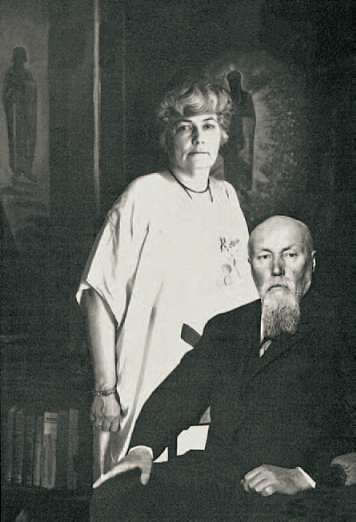
Helena and Nicholas Roerich
When he started to fulfill his idea of Museion, cherished in his high dreams, Nicholas Roerich had already acquired immense experience of cultural work in Russia as well as in Europe and America. Creative achievements of Roerich were so great that idea had risen during his life to create a museum of his art as a center of world spiritual culture. It wasn’t his idea — it was a part of the Great Plan of spiritualizing humanity being carried out on our planet by the Forces of Light.
The first Roerich Museum was established in America in 1923, and after 6 years in New York was inaugurated a new 29-storey skyscraper — impressive cultural complex including exhibition halls with the paintings of Roerich and other artists, halls of oriental art, Tibetan library, concert hall, hall for movie shows, art school. Under the Museum’s aegis there were sections dealing with different currents of art and thought. There was also a chapel to St. Sergiy Radonezhsky.
The Museum was an initiator not only of cultural but also scientific projects, among which were two major expeditions, one to Central Asia and other to Manchuria. It unified activities of dozens of cultural organizations throughout the world, coordinated public movement connected with the Banner of Peace and Roerich Pact.
Light of Culture which shone so brightly in America, caused fierce attacks of darkness. Major damage was inflicted to the Great Affair when in the middle of 1930s the Museum’s building was seized by the treacherous hands.
Struggle for restitution of the Museum lasted for many years. Nicholas Roerich has passed from this life still expecting for justice to be restored. Soon after his passage, in 1948, in her letter to American co-workers Helena Ivanovna Roerich transmitted the words of the Great Master: ‘New Country will manifest on victory, and the Museum will be returned to you. Justice will be restored. Write to them: ‘Better degree will manifest in the new premise due to a new condition, due to a certain new condition. New Country will show interest to the Art of its great compatriot. The Country will manifest new evaluation of all his activities...’3
Thus the two concepts — Roerich Museum and the New Country (Russia) — are first put together.
Two years later Helena Ivanovna wrote: ‘You know how much G[reat] M[aster] appreciated N[icholas] Roerich’s paintings... and called him the best of the modern artists, and willed to put firmly his art throughout the world, to imbue the souls seeking and thirsting for Beauty. And of course the G[reat] M[aster] has the Plan how to collect the paintings, how to erect a monument to such an extraordinary Artist, Thinker and representative of the great humanism in the era of greatest inhumanity.’4
In 1949 activities of the Roerich Museum in New York was revived. Museum acquired its new building. Guided by tireless Zinaida Fosdick, the closest loyal co-worker of the Roerichs, the Museum continued the work started by the family of the great Light-Bearers.
Meanwhile, the hour of the New Country’s spiritual awakening was approaching.
One of the possible ways of the Great Plan of which it was said in the Teaching ‘Into the new Russia My first message’, was being fulfilled through the spiritual lineage descending from Nicholas Roerich to his closest disciple Boris Nikolayevich Abramov. ‘This tidings was to be delivered to Russian people. Great future is destined for Russia, and one had to start preparing this great future’, said Natalia Dmitriyevna Spirina, a disciple of B.N. Abramov, when she explained why they had to return back to Russia from emigration in China.
Undoubtedly, scenes of the destined future of Russia were being slightly opened to Boris Nikolayevich. It becomes clear from his notes and conversations with his disciples. ‘What was created is now being realized in life. New center of Culture is being established there — north, a town with Slavonic name’5 (1957).
‘You know the Purpose, you know the Plan, you know how and where to apply your forces...’6 (1958). ‘Not small place and labor are allotted for us in the future. Acceleration goes on geometric progression. Prepare your consciousness for unexpected things. The sole purpose is to prepare people to the Advent. There will be the Museum and reproductions of all sizes’7 (1958).
At the end of the 1950s, before Boris Nikolayevich and Natalia Dmitriyevna returned to Russia from Harbin, many prospects might seem impossible. But still, as the terms were coming, nothing could stop fulfilling of the predestined.
Let us trace the events of the four years.
1957. By the invitation of Nikita Khrushchev George Roerich came back to Russia. He presented as a gift to his motherland more than 400 Nicholas Roerich’s paintings.
1958. In the halls of the Moscow Union of the Artists was held the first exhibition of the Roerich paintings recently brought. Then this exhibition started its travel through the towns and cities of the Soviet Union.
1959. N.D. Spirina and B.N. Abramov came back from Harbin to Novosibirsk. They brought with themselves the books of the Teaching of Living Ethics and the Notes of Boris Nikolayevich.
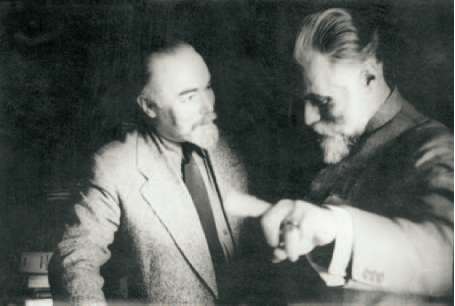
George and Svetoslav Roerich. 1960
1960. By the invitation of Nikita Khrushchev Svetoslav Roerich came to Moscow with his works, and his personal exhibition was opened in the Pushkin State Museum of Arts.
In the same year Novosibirsk received a priceless gift — Nicholas Roerich’s paintings from the collection brought to Russia by George Roerich. Official opening of the exhibit took place at the Novosibirsk Art Gallery on the 27th of September. Since that date 60 canvasses of the great artist had to be on the permanent exposition, as a condition put by the grantor.
One must notice that the paintings arrived to Novosibirsk at almost the same time as N.D. Spirina and B.N. Abramov came here. Boris Nikolayevich lived in Novosibirsk for about one year. It is known that he took part in arranging the paintings and preparing the exposition to its opening. For some time he was working at the Regional library which was situated just close to the Art Gallery, so he could visit the Roerich hall in the gallery quite often. Soon, under the pressure of circumstances, he left from Novosibirsk, but there stayed his disciple, N.D. Spirina.
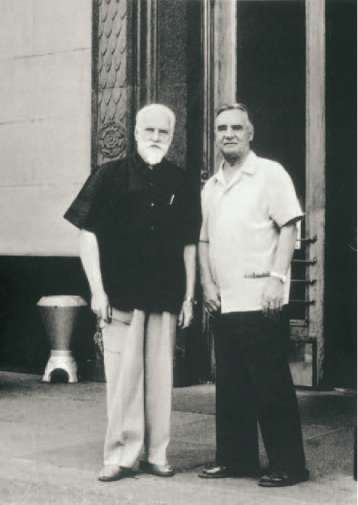
Svetoslav Roerich and Paul Belikov. 1960
After George Roerich’s return to the Soviet Union in his conversations he often mentioned a plan of creation of Nicholas Roerich’s Museum in Russia. George had discussed this question at the Ministry of Culture. Besides Moscow and Leningrad — cities where such museums were planned — was also first mentioned the large region of Siberia — the Altai.
Imbuing of space with the thoughts about creating the Museum was continued after George Roerich’s passing away. In the notes of conversations between Natalia Dmitriyevna and Boris Nikolayevich made in 1967 one can find a reference to such a museum again: ‘Think: ‘Guru’s Museum’ — it was one of the formulas which Boris Nikolayevich gave for the continuous affirmation on the plane of thought. ‘Builder of life can’t be passive or inactive. When it’s impossible to build with one’s hands and in external activity, then he would build by his thought’8, wrote B.N. Abramov in his notes. ‘The basis of creative work is one’s skill to visualize the desired image brightly, definitely and colorfully in one’s mental sight, to embody it later into the gross form’9, wrote B.N. Abramov.
Then came the years of so-called Stagnation, when there were obviously no possibilities for fulfilling the thoughts of the Museum. Roerich Art was surrounded with silence, his philosophy was silently prohibited. But nobody could prevent people from thinking about the Museum.
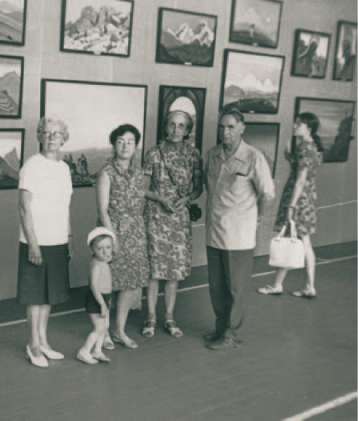
N. Spirina and P. Belikov at the exhibition of Nicholas Roerich’s pictures. 1975
Years were passing which were filled for Natalia Dmitriyevna mostly with inner activity of which we can only make conjectures. Since 1973 preparation to celebrate Nicholas Roerich’s centenary was started in the country. In 1974, after long interlude, Svetoslav Roerich again visited Russia. Along with his own paintings he brought also his father’s ones. Exhibition had unprecedented success both in Moscow and in Leningrad.
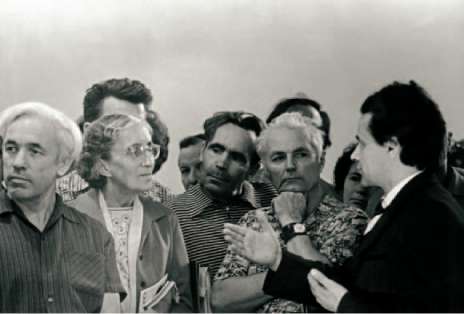
Natalia Spirina as a guide. 1970s
Novosibirsk also had an opportunity to see great artists’ works not known to wide public. On the exhibitions of Nicholas and Svetoslav Roerich held in Academgorodok (1973), in sports center of the Novosibirsk State University and in the halls of the Novosibirsk Art Gallery (1975) N.D. Spirina was a permanent consultant and guide. It was a chance dreamt of for many years. Being a musician and expert in poetry, Natalia Spirina created a literature-musical slide-show programs and presented them with the help of E. Matochkin and L. Shkutin in the musical drawing-room of the Scientists’ House in Academgorodok. These meetings seemed to be nothing special in their exterior — live music playing, poetry reading, telling about the artist and his works accompanied by the slide-show. But the people who attended to these meetings were stunned and inspired: they had never seen nothing similar before.
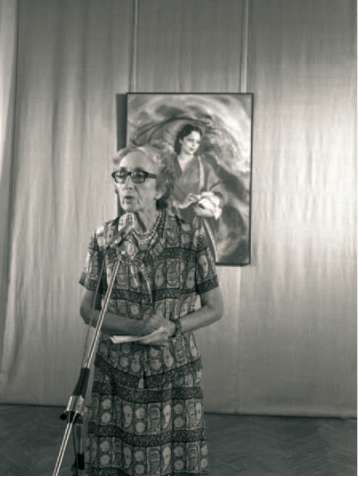
Natalia Spirina at the exhibition of Nickolas and Svetoslav Roerichs’ pictures
Interest to Roerich’s art was continuously growing, and Natalia Dmitriyevna was repeatedly invited to lecture at the Art Gallery, at the University, at the Pedagogical Institute, at the libraries, schools, student clubs, her lectures had great success at the book store of the Academgorok Shopping Center and at the Central Book Store in Novosibirsk. Her programs ‘Images of Roerich’ and ‘Roerich and Music’ were so popular that she was being requested to repeat them.
About all this — her cultural, educational work and the general interest to Roerich’s art, especially among the youth — Natalia Dmitriyevna wrote to Pavel Fedorovich Belikov who was interested in everything concerning popularization of Roerich’s art. Answering to one of such letters Belikov wrote: ‘Activities of Novosibirsk people, surely facilitated by the exhibition, and the meetings you arranged, bring ineffable joy to my heart. Because everything which some fifteen years ago seemed to be related to indefinite future, now makes itself powerfully felt in our today. ‘The Call’ is not only given but already heard, and among those who heard are many young hearts, which is especially reassuring. To pass on the baton — it was the main task for our generation. And now this main task is being fulfilled in spite of the recently so compelling ‘evidence.’
Natalia Dmitriyevna shared with Pavel Fedorovich her ideas about creating in Novosibirsk a museum of Nicholas Roerich. Belikov who was in direct contact with Svetoslav Roerich discussed this question with him at her request. So in Belikov’s correspondence to N.D. Spirina we find a valuable document — composed by Svetoslav Roerich detailed plan of creation entire net of memorial museums in the places where Roerich lived, worked or travelled, with the Center in a large city.
As far back as in 1974, when the plans of constructing Roerich Museum in Novosibirsk were discussed, it was supposed to be a ‘people’s construction’. The idea of creating the Museum was of course supported by Pavel Fedorovich: ‘Let the grand Museum will serve as magnet. And let it inspire people for everyday work, may be for some of us the most difficult work, but the most necessary.’ But at the same time P.F. Belikov expressed his doubts concerning possibility of fulfilling these plans at that time and in that way: ‘It’s too difficult task, there are too few ‘people’s constructions‘ and appropriate ‘funds’. To get such a status is almost hopeless affair’.
Taking into account that in officials’ understanding museum is just a storage of art pieces and nothing above that, one can see why P.F. Belikov, although the Novosibirsk Art Gallery already had 60 Roerich paintings, still warned: ‘You’ll have to prove necessity of the museum by the exhibits present, and you still have very few of them. Therefore it’s necessary to get such exhibits though for temporary exposition from different store-rooms, make a temporary exhibition somewhere (perhaps with the help of A.P. Okladnikov in the premises of Siberian branch of Academy of Sciences) and basing upon these facts to solicit for a special Museum.’
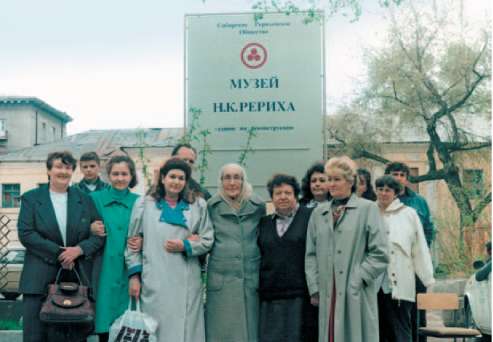
Natalia Spirina with her colleagues from the Siberian Roerich Society at the would-be Museum. 1997
Of course each museum of arts will consider it an honor to have a rich collection of originals. But what kind of museum was visualized by Natalia Dmitriyevna? Undoubtedly it should correspond above all to Nicholas Roerich’s own concept of Museum as ‘dwelling of all kinds of the Beautiful,’ as a union of Art and Knowledge, directed to serve the People’s Good, to improve human life on Earth.
The artist’s son Svetoslav Roerich also dreamt of constructing such a museum, he said about this as follows: ‘Above all it must be a living center. Not just a museum exposition, but continuously changed exhibitions — paintings, handicrafts, children’s works, and... on the international scale. Of course, besides that the works of Nicholas Roerich must be on the permanent exposition.’
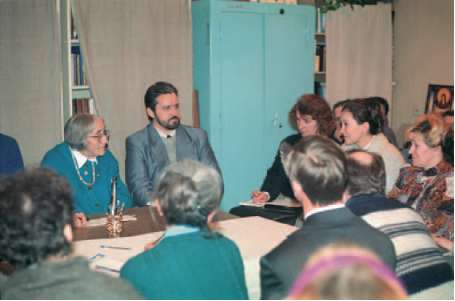
Natalia Spirina at the meeting with her colleagues from different Roerich societies. 1990s
‘This center may also include a lecture and concert hall, studios for young artists, and workshops for revival and preservation of the people’s handicrafts... Undoubtedly, the center must have as its part a big library with collection of books on history of culture, art, philosophy of Russia, East and West, including of course the works of Nicholas and Helena Roerich. [...] But I visualize this center also as a scientific institution. It might have as its task not only systematizing and studying the vast legacy of N.K. and H.I. [Roerich] but also further development of the ideas expressed in this legacy.’10
In the early 1990s Svetoslav Roerich handed over to Russia the legacy of Helena and Nicholas Roerich. Soon after that in Moscow a public Roerich Museum which accommodated this priceless heritage was inaugurated. Moscow Roerich Museum needing help in the process of its formation received great support from many Roerich societies.
Among them was the Siberian Roerich Society (SibRO) — a cultural and educational organization established in 1991 in Novosibirsk by Natalia Dmitriyevna Spirina. This society unified the people who were interested not only in Roerich’s art but also in his philosophy and accepted the Teaching of Living Ethics as the basis of their life.
The Siberian Roerich Society was quartered in the building of the Novosibirsk Art Gallery — at first in two rooms on the ground floor, then in a small semi-basement room. There worked the publishing house, library, there was a studio creating slide show compositions, there were prepared the ‘round tables’, pedagogical workshops, conferences, including the Roerich Conference.
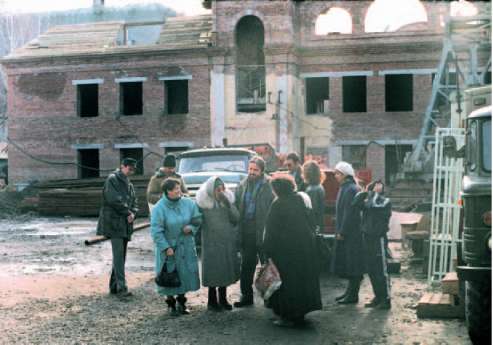
Natalia Spirina with her colleagues at the building yard. 1998
Academician Alexander Leonovich Yanshin who visited Novosibirsk in 1996 said: ‘I must emphasize that the Siberian Roerich Society... at present is a mighty force... It was a pleasant surprise for me to see their vast publishing activities, spreading the teaching through brochures, through publishing the magazine — it is very timely’.
Idea of creating Roerich Museum in Novosibirsk unified more and more people. It was evidenced in the written replays of the visitors of numerous SibRO’s exhibitions of Roerich paintings and reproductions. This idea was being discussed by the cultural community, by Siberian scientists and the city’s officials of different levels. On behalf of the Siberian Roerich Society negotiations with Svetoslav Nikolayevich about creating such a Museum conducted chairman of Presidium of Siberian Branch of the Russian Academy of Sciences Academician Valentin Afanasyevich Koptug. Svetoslav Nikolayevich appreciated this idea very much and expressed his desire to visit Novosibirsk.
In 1992 Novosibirsk city administration decided to establish Roerich Center-Museum on the basis of SibRO. But years passed until this decision was fulfilled — years filled not only with intensive searching for an appropriate premises, but also with numerous court cases with the governing body of the Art Gallery which did their best to evict SibRO from its two semi-basement rooms to the street.
The help offered in these difficult years by many people and especially such a prominent scientists as V.A. Koptug, A.L. Yanshin, A.A. Trofimuk, resulted in realization of the purpose to which thought of our Guides was leading us for so many years: on the 6th of December, 1996 Novosibirsk city administration took decision to allot to SibRO an old half-ruined building in downtown for constructing the Museum. This was a beginning of a new period in SibRO’s existence. The allotted building required not only reparation, but complete reconstruction. The Museum’s construction, as was suggested by Natalia Spirina, was proclaimed a ‘people’s construction.’
One must keep in mind that this unprecedented construction which was inaugurated by the fiery thought of its inspirer, Natalia Dmitriyevna Spirina, took place in very difficult times for our country: ‘collapse’ of Ruble, general pauperization, political instability... But in spite of obstacles of all kinds, the construction was moving ahead.
At the same time in the village of Verkhniy Uymon in Mountain Altai the Siberian Roerich Society started the work of reconstruction of Old Believer V.S. Atamanov’s house (where the Roerichs were staying during their Central-Asiatic expedition), for further establishing there the Memorial Museum-House of Nicholas Roerich. Besides this SibRO’s cultural and educational activities were continued, monthly magazine ‘Before the Dawn’ was being published. On its pages there was a column titled ‘To be able to help — that is happiness’ where the gratitude was expressed to everyone who did what they could to help the construction of the Museum.
Natalia Dmitriyevna once said: ‘We cherish the idea that there will be written a book about the Museum’s construction, how it was being born, built and created. It will be most amazing and captivating reading just as a most absorbing novel.’
But the construction was still far from completion and the difficulties which were appearing sometimes seemed irresistible. But only seemed. It is well known that obstacles spur one to mobilize all one’s forces and help to unite everyone who is capable of uniting. Besides that this work allowed everyone to show one’s adherence not only to the Teaching but to the Earth Teacher.
‘We are building the Museum and the Museum is building us’ — this aphoristic expression of Natalia Dmitriyevna quite accurately describes the process which was going on there. The Museum’s construction became a school of building up the relationships, a school where everyone acquired unparalleled experience of self-perfection. Overcoming the inner and external obstacles all the co-workers were being tempered: ‘Thus heavy hummer smashes glass and forges damask steel.’
Novosibirsk Museum was a development of Roerich’s idea of Museion at the evolutionarily new stage — in the years called by N.D. Spirina ‘the Epoch of Living Ethics’, when the Teaching given by the Great Masters became a common property being spread so widely.
In June, 1999 Natalia Dmitriyevna said: ‘Construction of our Museum is the dictate of the terms, it must be built and it will be built by the certain term.’
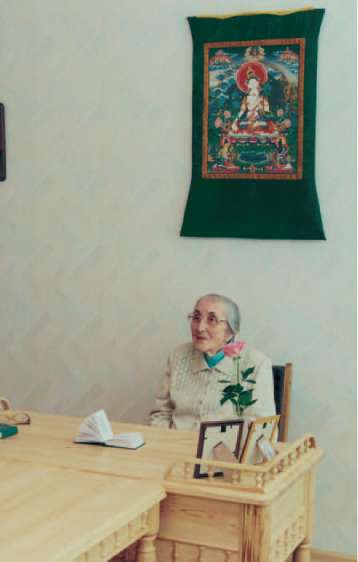
Natalia Spirina in her study at the Museum. 2002
In these years in her talks and lectures Natalia Dmitriyevna told that the walls of the museum must be animated with the burning of hearts of the people working here, and this fire will be felt by the Museum’s visitors, it will inflame above any words. ‘To build the walls it’s yet not all,’ she said in July, 1999. ‘Nice building, even filled up with paintings, is not yet what we need. The most important thing we need are people which will be able to fill this building with spirit. And who are these people? We are, because no one except us can do it. Later on we’ll be changed by the younger generation, but we must live and work until this will happen.’ The beautiful pieces of art will not have their beneficial influence if they are surrounded by indifferent people, believed Natalia Dmitriyevna. That’s why she considered the most important to create at the Museum atmosphere of the true Service to the Higher and Beautiful. Thus spiritual filling became a foundation of all the Museum’s activities. It was the guideline.
Natalia Dmitriyevna kept control of all the problems and happenings on the construction and in SibRO itself, as well as in the Roerich societies which took part in the construction. The year 2000 was one of the most difficult. At the Round Table in November Natalia Dmitriyevna read her word ‘Warrior Unconquerable’ dedicated to the Leader of the Heavenly Hosts, Archangel Mikhail. In conclusion of her speech she said: ‘And now we want to unite our hearts and address for the supreme assistance. In the name of the Wisdom and Beauty brought to us from on High, let’s ask the Guide of the Great Ethereal Forces Archistratig Mikhail to direct His Might and Help to the very difficult affair — creating in Asiatic Russia the first in Siberian Land Museum dedicated to Nicholas Roerich and his art. The construction has already been commenced. Let’s address our hearty appeal to the Great Heart of the Guide of the Heavenly Forces to patronize us in the good Affair of completing the started.’
This unusual appeal became a joint prayer-address. Nothing similar to this has been neither before nor after that.
Natalia Dmitriyevna called everyone upon to help the construction in one’s thoughts: ‘One may already begin to rejoice at our Museum! It will materialize it.’ ‘When one thinks about its destination, that beginning of the Future is commenced, that the Museum will develop into the Center — on the planetary scale — heart is filled with solemnity.’ ‘The Museum is the Teachings promotion in a material form. It will be filled with the Spirit of the Teaching. By our hands the miracle is being created.’
When asked ‘How should we prepare to opening of the Museum internally’ Natalia Dmitriyevna answered: ‘The most important is that the Museum exists, for the country, for humanity, for the planet. If we understand firmly what is the scale of the Museum and what is its significance for the future generations, — we’ll be ready. And this will determine the opening of the Museum. This is like the flag which is brought ahead of the army.’
‘Feel the Museum! It depends on our thoughts, which we put in it. And the wider is the scale of you visualizations, the greater will be the Museum, and it will strengthen every day!’
‘Some day we’ll gather in the Museum, near the fireplace, with flowers, roses, with our joy. It will be a quiet oasis of light in the city downtown, a refuge of the Spirit — in the center of ‘Babylon’. It will never be without the visitors — people will come here from everywhere just to visit the place! They will bring the memorial gifts, and the paintings will be there. Inside the Museum will be so beautiful, so clean, so unsullied atmosphere, just like in the Supermundane world, soul will rest here. People will come, breath this spiritual air. The Museum’s fundament is strong, because it is on the evolutionary basis.’
Ten years of construction have passed — ten most difficult and most beautiful unforgettable years. The friends and co-workers of the Novosibirsk Roerich Museum understand that they completed just the first step on the endless path to Infinity, which we are inspired to follow by the Teaching of the New Epoch — Natalia Dmitriyevna summoned them all to follow this path. And how much more joint efforts and toil must be exerted to make the Museum fully embodying the Vision of the Elder Ones.
Anastasia Bodrova, Irina Serebrova
1 Roerich N.K. Tverdynya Plamennaya. Riga: Vieda, 1991, p. 202.
2 Ibid., p. 240.
3 Roerich E.I. U poroga Novogo Mira. Moscow, 2000. 13.11.1948.
4 Roerich E.I. U poroga Novogo Mira. 28.11.1950.
5 Iskry Sveta. Iss. 2 – 3. Novosibirsk, 2000, p. 47.
6 Grani Agni Yogi. 1958. Novosibirsk, 2007, p. 32.
7 Iskry Sveta. Iss. 4. Novosibirsk, 2000, p. 5
8 Grani Agni Yogi. VI. 528.
9 Grani Agni Yogi. II. 98.
10 Roerich S.N. Medlit’ nelzya. Sovetskaya kultura. 29.09.1989.
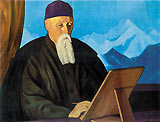
Музей Н.К.Рериха в центре города Новосибирска построен Сибирским Рериховским Обществом методом народной стройки, то есть на добровольные пожертвования множества людей и организаций. Многие приезжали со всей страны в свои отпуска для выполнения работ.
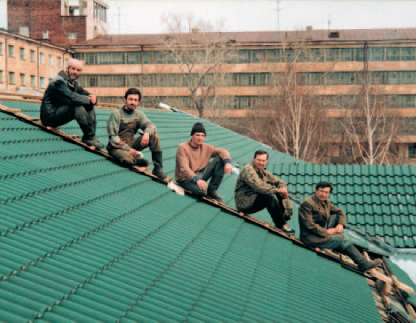
Инициатору и вдохновителю строительства Музея – Наталии Дмитриевне Спириной – в момент начала строительства было 86 лет.
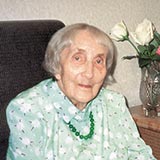
Возведение Музея Рериха в Новосибирске началось с полной реконструкции в 1997 году полуразрушенного детского садика (стены разбирались почти до фундамента).
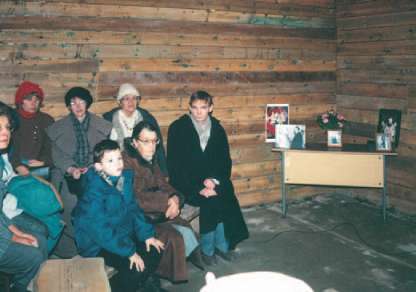
Интерес к строительству из разных городов России и зарубежья был так велик, что выставки и слайдпрограммы для приезжающих гостей начали понемногу проходить ещё в неотштукатуренных помещениях строящегося Музея.
Неофициальное открытие Музея произошло 4 мая 2001 года, в день празднования 90-летнего юбилея Н.Д.Спириной.
Официально Музей открыт с 7 октября 2007 года.
